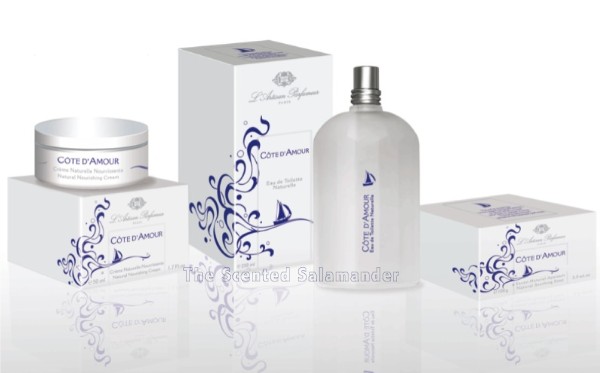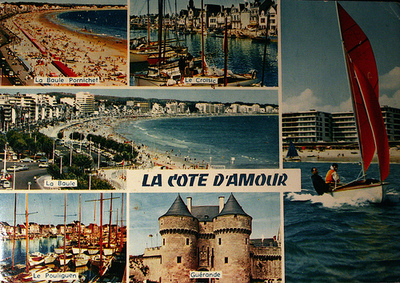L'Artisan Parfumeur Cote d'Amour (2009): The Risk of the Central Perfume Motif, with a Comparative Note on Diorissimo {Perfume Review} {New Fragrance}


Paramnésie by Christine Lebrasseur
Côte d'Amour is the latest L'Artisan Parfumeur from their 100% natural and organic series to come with Ecocert and Cosmebio certifications. As June 5, 2009 is international Environment Day to be celebrated on a global scale with the launch in 130 countries of the earth movie Home by Yann Arthus-Bertrand co-produced by Luc Besson and François-Henri Pinault of PPR, this is a fitting fragrance to consider wearing as a tribute, and beyond the gesture consider the interest of a new school of perfumes.
 For those who cannot make it to the movies on Friday, the film which looks simply stunning from the preview images (see website), will be available on You Tube as this is a social project rather than a financial one (entry fees are waved or nominal - 2 € in Europe). The movie is meant to call attention to the unique beauty of planet earth, the dangers that beset it and the possible venues to remedy the issues at hand, chief amongst them climate warming. Yann Arthus-Bertrand has become famous for his breathtakingly beautiful aerial landscape photography, and although Côte d'Amour strikes a more intimate, familial chord it also manages to encompass in its own way the atmosphere of a long stretch of summery northern beach coast with the application of just a few drops of perfume. Moreover it does so with the same good intentions and to satisfy ethically-oriented customers...
For those who cannot make it to the movies on Friday, the film which looks simply stunning from the preview images (see website), will be available on You Tube as this is a social project rather than a financial one (entry fees are waved or nominal - 2 € in Europe). The movie is meant to call attention to the unique beauty of planet earth, the dangers that beset it and the possible venues to remedy the issues at hand, chief amongst them climate warming. Yann Arthus-Bertrand has become famous for his breathtakingly beautiful aerial landscape photography, and although Côte d'Amour strikes a more intimate, familial chord it also manages to encompass in its own way the atmosphere of a long stretch of summery northern beach coast with the application of just a few drops of perfume. Moreover it does so with the same good intentions and to satisfy ethically-oriented customers... There are more and more perfumes in the less-than-confidential portion of the market that come with a sustainable green message and their compositions are expected to become increasingly sophisticated as perfumers rediscover the art of natural perfumery and industrialists focus on developing the sector.
Côte d'Amour classified as an "eau de toilette naturelle" comes after an initial inroad in that category by L'Artisan Parfumeur with l'Eau de Jatamansi launched in 2007. If L'Eau de Jatamansi was closer in its herbalist references to the specter of the infamous "medicinal" nuance given off by natural perfumes, Côte d'Amour is a concerted and successful effort to go beyond that point of reference and avoid what is commonly seen as a pitfall of natural perfumery by people whose sensitivities were shaped by XXth century perfumery. In other words it is an attempt to preserve the less literalist, figurative heritage of synthetic-cum-natural perfumery but express it with an exclusively natural and organic palette. It is ironic in a way that one of the most instantly recognizable synthetic molecules, the sea spray of Calone, is dealt away with and replaced by natural salty nuances.

A vintage 1970s postcard of the Côte d'Amour uploaded by Miss Shari
The new perfume inspired by a stroll along the Côte d'Amour in Brittany was composed by perfumer Céline Ellena, the daughter of nose Jean-Claude Ellena. Her signature in this case is not too far off from that of her father's as one could see here a team reflection on mineral notes (cf. the flint note in Terre d'Hermès) and a certain common sensitivity for a mix of modernist synthetic design and simple sensuality.
Côte d'Amour manages to be both artistic in its ability to showcase the stylized photography of a beach and tenderly affective in its summoning up of memory-loaded impressions of a coastal summer.
I see a parallel in one respect with an unlikely companion, Diorissimo by Dior, which also makes use of a quintessentially, for the French, spring note, muguet, but beyond that invites one's gaze to contemplate a panorama of the spring season rather than stay at the level of a lily of the valley soliflore. Diorissimo is or rather was great until the most recent reformulation (I am going to review 3 incarnations of it) because it was able to embody the whole atmosphere of spring with a few suggestive touches. Côte d'Amour somehow does something similar taking a marine accord and opening up a larger vista onto summer. It also smells very French to my nose from beginning to end while Diorissimo starts French but then loses you into an unknown territory where it is springtime somewhere not too distant from paradise. To me Côte d'Amour does not quite attain the same level of abstract universality as Diorissimo did with its ability to conjure up a representation of the idea of spring as in the depiction of the vernal season in Primavera by Botticelli, perhaps due to the more limiting note of a culturally-connoted scent of sunscreen but also due to a more family-oriented psychological orientation.
Finally the perfume ties these two main orientations with a sensual, more universal resolution by approaching the scent of skin underneath a certain cultural layer of olfactorily-coded evocations.
How It Smells & Wafts
Notes are: green mandarin, pink grapefruit, rosemary; immortelle, cypress, gorse bush, coconut, rose; broom, heather, pine.
The perfume opens on the characteristic smell of those first few drops of rain water that would have hit a big beach pebble baked white-hot by the sun. The scent initially plays upon the contrast of dryness, hotness and minerality, and more in the background there is saltiness and sweetness (a bit prune-y with a nuance of leathery olive); the famous salt marshes of Guérande are not far inland. The impression is slightly dusty as well conjuring up the images of a round, gray and porous pebble oscillating in the direction of the sensation of a fine layer of sand lingering on the skin. The aesthetic is hyper-realistic concentrating on sensations of spending a summer at the beach skin against sand while offering a macro perspective of the details of beachside life as in a photographic nature morte, except that there is the sense of scented soft air caressing the skin.
As the perfume evolves it keeps the contrasted theme of a wet and dry minerality running throughout while sweet and soft resinous nuances smelling of cistus, rosewood, pine, that is, a bit sweet, are worked into the perfume to evoke the balmy air of the shore. But also now a supplementary nuance surfaces, that of the scent of skin with traces of sweetly soft amber-y sunscreen on it at whisper level, this time like a polaroid snapshot of the family holidays in the past but also upcoming this summer. Wearing this scent in the city it immediately evokes farniente at a Parisian terrace café over lunch break baking in the sun.
The sea-water, marine context is perceptible through the smell of iodine as well as light bleach evoking that sensation of clean that is specific to the seaside where skin and clothing are washed not only by soap and water but also the sun, the elements - wind and water, the rain, sand.
The perfume further softens down turning into an intimate skin scent with accents of driftwood and flotsam - suddenly the pebble recedes in the background but a gnarled branch of driftwood abandoned on the beach takes its place. The drydown is softly woodsy and rosy, winning in its discreet pleasant sensuality while not being what I would term exactly light. In fact, there is a certain sustained strength to the perfume which is able to last into the next day. This is considered a technical feat as natural perfumes do not benefit from as strong fixatives as synthetic ones and natural animalic notes which may have helped weigh down perfumes in the past are not allowed to be used commercially. Here the resins help give lastingness and depth to the perfume. L'Eau de Jatamansi is lighter by comparison .
The composition has a hyper-realistic modernist feel in the beginning to it but refuses to stay at that level of perception which might render it too conceptual. It seeks emotion through the triggering of childhood memories, the setting up of a family ambiance, the call of memories and anticipation of easy summers. The French will no doubt discern a "Petit Bateau" charm to it, this orchestration of our summer marine emotions around the simplicity of the colors marine blue and white and the stripes they make on mariners' tee-shirts. The iconicity of the Petit Bateau readywear brand worn by generations of French children was given the nod it seems in the little blue boat that adorns both the inner and outer packaging for the perfume. The 250 ml bottle itself looks like an Eau de Cologne bottle for the family and could certainly be used that way (the glass is transparent and frosted and not white as on the picture). The one potential problem I see is that the perfume is so evocative of summer at the beachfront that it might not be easy for it to transcend its seasonal status. The composition is not abstract enough to blend in as a mere suggestion of seaside escapism. It plants an olfactory decor like the scene where Baldini in the movie Perfume The Story of a Murderer smelling the fragrance Nuits Napolitaines suddenly finds himself in Napoli. While l'Eau de Jatamansi manages in the end to smell subtly good without conjuring up a monastery in the Himalayas, I am forever brought back to the shore with Côte d'Amour. In this resides a limitation but of course a great ability to create illusion as well.

Transcendence by wildpianist
Thus bridging the genres of the perfume to be smelled and the perfume to be worn, Côte d'Amour is a bit weighed down by this tension between a contemplative and hedonistic marine motif. Unlike Diorissimo which managed to shed the lily-of-the-valley-bouquet motif to evoke the spirit of spring decanted further into a spirit of renewal, hope and sheer exhileration, Côte d'Amour stays too close to a sense of summery pause and slow-moving comfort to take its flight from the coastal line of the coast into say the great mystical beyond of the sea. We are not just anywhere, as announced, we are on a particular geographic shoreline. Perhaps more blues than blue would have added the necessary psychological depth. Or something could have made more complex the summery sense of sleepiness. As it is, one feels certain that many persons will relive happy memories with this perfume and enjoy its arty, experimental, nostalgic, oh-so-summery and sensual personality.
Needless to say, as far as natural and organic perfumes go it is an excellent and even an outstanding perfume which is several step ups in the quality and range of expression offered by this kind of perfumery. Côte d'Amour keeps the details of the marine motif unfolding for hours on; it lasts more than some synthetic-cum-natural perfumes, like, say, the very latest version of Diorissimo.









